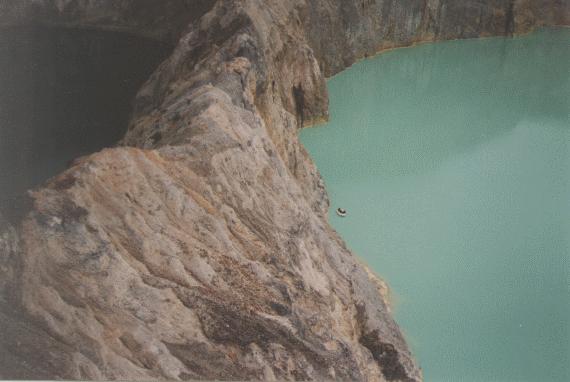Report on Kelimutu (Indonesia) — June 1995
Bulletin of the Global Volcanism Network, vol. 20, no. 6 (June 1995)
Managing Editor: Richard Wunderman.
Kelimutu (Indonesia) Minor bubbling in very acidic crater lake
Please cite this report as:
Global Volcanism Program, 1995. Report on Kelimutu (Indonesia) (Wunderman, R., ed.). Bulletin of the Global Volcanism Network, 20:6. Smithsonian Institution. https://doi.org/10.5479/si.GVP.BGVN199506-264140
Kelimutu
Indonesia
8.77°S, 121.82°E; summit elev. 1639 m
All times are local (unless otherwise noted)
Between 15 and 19 May 1995 a search was conducted for the body of a missing Dutch tourist who had fallen into one of Kelimutu's three crater lakes (figures 1, 2, and 3). During the search of the turquoise-blue Tiwu Nua Muri Kooh Tai lake, ~600 x 380 m in size and located 100-150 m below the crater rim, pH measured by litmus-paper was 0.5. Access to the crater lake was achieved by rope-aided descent, but rocks on the crater wall were very loose and rockfalls were frequent. A portable boat was used to tow a dredging net to comb the 3-6 m depth range of the entire lake. The water temperature was 37°C, ~8° cooler than the air. A film of yellow sulfur (~30 x 150 m) floated on the lake's surface. The searchers breathed bottled oxygen because of the high levels of SO2 in the air, which measured 5 ppm. On 18 May "little bubbles or very small fountains" were observed within the lake. Although the body was not recovered, the search was terminated on 19 May.
 |
Figure 1. Map of the summit area of Kelimutu showing the three crater lakes and the location of the volcano observatory. |
Further Reference. Outdoor Magazine, Bergingsactie op een actieve vulkaan, De Kelimutu Zwijgt, 3e jaargang:4, July 1995, p. 40-45 (in Dutch, with 14 photos).
Geological Summary. Kelimutu is a small, but well-known, Indonesian compound volcano in central Flores Island with three summit crater lakes of varying colors. The western lake, Tiwi Ata Mbupu (Lake of Old People) is commonly blue. Tiwu Nua Muri Kooh Tai (Lake of Young Men and Maidens) and Tiwu Ata Polo (Bewitched, or Enchanted Lake), which share a common crater wall, are commonly colored green and red, respectively, although lake colors periodically vary. Active upwelling, probably fed by subaqueous fumaroles, occurs at the two eastern lakes. The scenic lakes are a popular tourist destination and have been the source of minor phreatic eruptions in historical time. The summit is elongated 2 km in a WNW-ESE direction; the older cones of Kelido (3 km N) and Kelibara (2 km S).
Information Contacts: Ton Biesemaat, Outdoor Magazine, Netherlands; VSI; AP; UPI.



